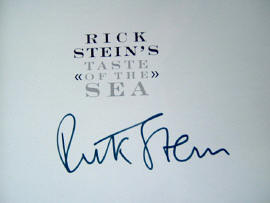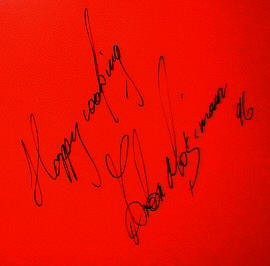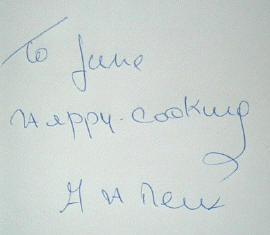|
Signed Cookery
Books - what is that signature really
worth?
from
Books and Bygones
We all have our favourite chef/cookery
writer. It may be articles published in
local newspapers or national magazines,
but what of the celebrity chefs who
publish several books each year? The
name Jamie Oliver springs to mind, but
is the added signature really going to
make that publication more saleable in
the future?
During the 19th century, very few
authors of cookery books signed their
works and, if they did, it was normally
to someone very special and the
inscription would be personalised. These
are referred to as ‘dedication copies’.
Following on from the very few, shall we
say rare, dedication copies the author
would normally inscribe copies for
members of their family, friends, and
their mentors or even for other writers.
These are known as association copies.
Finally, there would be copies simply
signed by the author.

The latter half of the 20th century saw
a tremendous increase in signed copies.
This of course coincided with the
upsurge in popular television chefs -
including Johnnie and Fanny Cradock,
Philip Harben and much later, the then
rather outrageous Graham Kerr. This
trend has continued and it is now quite
normal for celebrity chefs to ‘bulk’
sign their latest book before it leaves
the printers, with the result that some
of these copies appear in the market
place as remainder stock.
This brings us to the various types of
signings:-
First and as far as we can see the most
useless is the signed ‘slip’, loosely
inserted to the front of the book - the
publisher provides the author with a
large quantity of slips which for some
strange reason they then proceed to
sign.
Secondly, are those signings normally to
the title page and described by most
book dealers as ‘signed to the title
page’, although with the ever increasing
sales of books on the internet, a new
term of ‘flat signed’ is being used as a
description for this type of signature.
No other information as to date or
location of the signing is included, so
this type of signing can also be
completed before despatch to retail
outlets. However, the general trend is
for the author to hold ‘signing
sessions’ in town centre bookshops.
Another aspect to be aware of is the
facsimile signature, very common in
Victorian times, and normally found on
the frontispiece portrait of the author.
It is making an appearance again today,
particularly on autobiographies and
music related titles.

Thirdly, we have the general
inscription, “Happy Cooking, Anton
Mosimann ‘96”. This type of inscription
is not personalised, it relates to the
subject matter of the book, and again it
is the type of signing an author can
complete in bulk.

Fourthly, the personal inscription - “To
June, Happy-cooking, A.H. Roux” At least
you know the author had taken the time
to ask the owner of the book their name,
and who knows, with some further
research, it may prove to have been
someone of importance.

However… there are always exceptions.
What is the value of an inscribed
post-it note? At a chance meeting with
Antony Worrall Thompson in a local
restaurant, where unfortunately we did
not have a copy of one of his books for
him to sign, he cheerfully signed a
post-it note “Happy Eating, Antony
Worrall Thompson AWT’. Although this
signing is not specific to any one
title, to us as collectors and sellers
of cookery books, and AWT fans, it will
always be one very special signature.
Now to the value of a signature - the
same formula should apply as with any
collectable signature or autograph.
Validation of authenticity is of
paramount importance but how do you
check this? Ask any member of Ibooknet,
they will be only too pleased to offer
their advice.
As lifestyles change so will the value
of collectable items. Who in the early
20th century would have thought a
cookery book based on Chinese or Mexican
cookery would ever be a best seller? And
as the world becomes an ever smaller
place what will be the most popular
cuisine in 100 years time? We have
already experienced the upsurge of
‘fusion’ foods.
These factors will affect values but of
greater significance is the fact that,
as more authors sign more copies, those
without inscriptions will have less
value as collectable items in the
future. Finally, one thing that we
should not lose sight of is that
collecting is very personal and without
a buyer there is no value.
|

